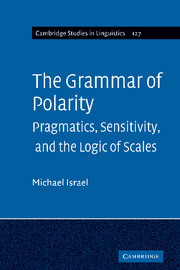Book contents
- Frontmatter
- Contents
- List of figures
- List of tables
- Acknowledgments
- List of abbreviations
- 1 Trivium pursuits
- 2 Ex nihilo: the grammar of polarity
- 3 Licensing and the logic of scalar models
- 4 Sensitivity as inherent scalar semantics
- 5 The elements of sensitivity
- 6 The scalar lexicon
- 7 The family of English indefinite polarity items
- 8 Polarity and the architecture of grammar
- 9 The pragmatics of polarity licensing
- 10 Visions and revisions
- Appendix: A catalogue of English polarity items
- Notes
- References
- General index
- Person index
3 - Licensing and the logic of scalar models
Published online by Cambridge University Press: 07 September 2011
- Frontmatter
- Contents
- List of figures
- List of tables
- Acknowledgments
- List of abbreviations
- 1 Trivium pursuits
- 2 Ex nihilo: the grammar of polarity
- 3 Licensing and the logic of scalar models
- 4 Sensitivity as inherent scalar semantics
- 5 The elements of sensitivity
- 6 The scalar lexicon
- 7 The family of English indefinite polarity items
- 8 Polarity and the architecture of grammar
- 9 The pragmatics of polarity licensing
- 10 Visions and revisions
- Appendix: A catalogue of English polarity items
- Notes
- References
- General index
- Person index
Summary
At the heart of social and emotional expression is the linguistic feature of intensity.
William Labov (1984: 43)What is a polarity context?
Polarity items are defined by their distributions – by their patterns of occurrence or non-occurrence in particular sorts of sentences and utterance contexts. But it is not obvious what it is that makes the loose conglomeration of contexts that affect polarity licensing a natural class. In English the contexts which license NPIs and inhibit PPIs include clauses and constituents not just in the scope of negation, but also in the scope of a question, the premise of a conditional, the standard of a comparison, or in the complements of certain intensional predicates (e.g. doubt, deny, sad, sorry, surprised, and amazed). Presumably all these contexts share some common property which explains their common behavior as “affective,” NPI-licensing contexts.
Broadly speaking, linguists since Klima have followed two basic strategies for explaining affectivity. The traditional assumption was that affective contexts are defined by their relation to negation (Klima 1964; Baker 1970; Linebarger 1980; Progovac 1994). The idea is implicit in the term negative polarity item itself, and in the loose but common use of negative contexts for NPI licensors generally (Buyssens 1959; van der Wouden 1997). Although many licensors are neither semantically nor grammatically negative, there is nonetheless a common intuition that “negation is the most central of them, while the others have various kinds of semantic or pragmatic connection with negation” (Huddleston & Pullum 2002: 834).
- Type
- Chapter
- Information
- The Grammar of PolarityPragmatics, Sensitivity, and the Logic of Scales, pp. 48 - 78Publisher: Cambridge University PressPrint publication year: 2011



